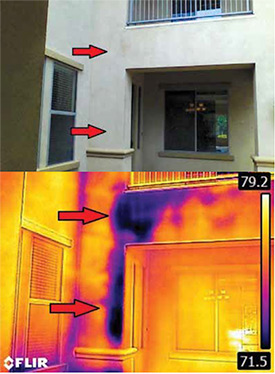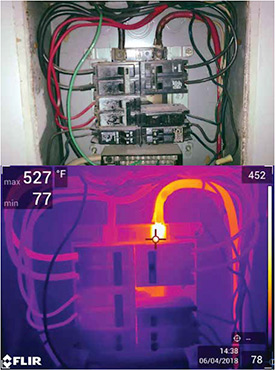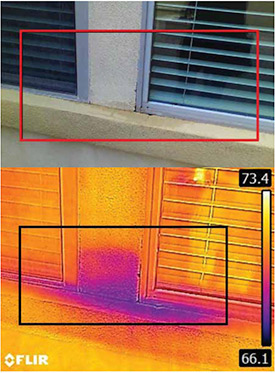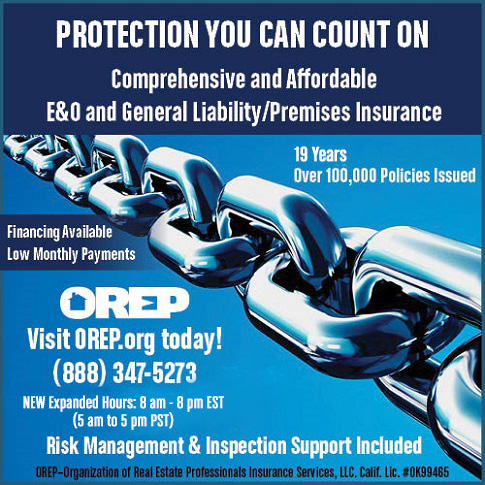 |
> E&O/GL Insurance for Home Inspectors Competitive Rates, Broad Coverage, Free Risk Management, online inspection support for tough questions, discounts on education and more... Professional Coverage, Competitive Pricing Shop OREP today! |
>> Editor’s Note: To help you stay up-to-date and connected, OREP/Working RE has established a Coronavirus (COVID-19) Discussion and Resource Page where you can share your thoughts, experiences, advice and challenges with fellow inspectors. See what Inspectors are saying here!
>> Take the Coronavirus: National Home Inspector’s Survey. Provide your industry feedback.
Training Certifications and Value-Add of Infrared
by Christopher Casey, CEO at Monroe Infrared
A few years ago, I wrote an article for Working RE entitled IR for Home Inspectors Today, which focused on the three top misconceptions inspectors had at the time regarding Infrared (IR) inspections: that it is too expensive, that customers won’t pay more for IR, and IR will increase liability exposure. (Visit WorkingRE.com to read the article.) All three of these objections discussed in that story seem to be a thing of the past.
Today, the real focus with respect to Infrared and other Value-Added Services (VAS) is that they help you differentiate yourself from your competition. When you add more services, you stand apart from prospects and those ever-so-valuable affinity clients called real estate agents. The path to adding VAS is earning training certificates. The number of training and certification classes available for home inspectors today is truly huge! Here is but a partial list of what is available, and to one degree or another, recommended or expected:
• Stucco Inspector Certification
• Mold Inspector Certification
• Lawn Irrigation System Inspector
• Wind Mitigation Inspector
• Indoor Air Quality Inspector Certification
• And there are many more!
Many value-added services (VAS) that home inspectors embrace today can provide real value to clients and generate tangible revenue to the bottom line. Most VAS help to alleviate fear of the unknown for your clients regarding such issues as moisture/water leaks and mold, air quality problems, structural and sewer integrity, radon and the potential for health issues, and termites that are silently damaging the home, to name a few.
There are classes and related certifications offered by national and state associations as well as private training organizations like ours. How do you pick? The key is to choose the ones that will produce the greatest impact, value and differentiation for you and your business. Focus on return on investment (ROI) with respect to your own situation and do your homework on your competitors! Is the service being offered by inspectors in your marketplace? What is the cost to begin offering it: how much to get trained and certified and to get the word out? Are inspectors charging for the service or simply adding it free? If they are charging, how much? How comprehensive is the inspection and report?
The pen and clipboard days of home inspections are long gone. Those of you reading right now already realize that if you’re not embracing technology, you are rapidly falling behind your competition and the expectations of your clients. Today’s homebuyers, sellers and the agents who represent them are savvy technically with high expectations that nearly all information be made available digitally for review. Technology is both respected and expected. And technology is noticed when it is absent or when an inspector fails to meet high expectations. All of which can lead to a prospective client calling another inspector or an agent recommending a different
home inspector.
Infrared Inspections
Infrared inspection is one VAS that is relatively new to home inspectors. An infrared camera is a powerful tool in the hands of a well-trained, competent and thermography-certified home inspector. Monroe Infrared has worked with and trained home inspectors for nearly 10 years. Monroe’s Certified Residential Thermography (CRT) class was developed for home inspectors, by working closely with the national associations. In 2012, most home inspectors considered infrared too expensive, not wanted by clients and a liability risk. Those objections are history, as I mentioned at the start of this article.
(story continues below)
(story continues)
Interest in infrared began in movies and television where thermal imaging capability was, to be honest, a bit overstated. As the technology advanced and interest developed, so too did the miniaturizing of thermal detectors in conjunction with lowering of the costs of IR cameras. Today’s home inspectors have an array of thermal imaging cameras to choose from that will absolutely improve their visual inspections. And to those inspectors who enhance their knowledge and fine-tune the nuanced skills of thermography (which are no different than other skilled trades such as electrical, plumbing, HVAC pipefitting, etc.), the spoils of business growth and increased profitability await.
Today the use of IR cameras by home inspectors is reaching 50% penetration across the country; in some areas it is closing in on 75% or higher. This means the use of an IR camera as part of a comprehensive home inspection is becoming the norm. Many home inspectors have told us they need to begin offering infrared or real estate agents will not continue recommending them because clients expect the added value perceived with infrared.
Training & Certification
The home inspection industry has recognized that buying an IR camera doesn’t make you a qualified and confident thermal camera operator any more than buying a scalpel qualifies someone to be a surgeon. Identifying the training and recognized certification associated with successful completion of class provides benefits to you and your business.
The CRT certification and logo are earned by home inspectors by completing the course and successfully passing a final test. The use of a certification should be made available to graduates and used in their marketing and sales efforts to establish their credibility and differentiate themselves from competitors. The education of your customers is KEY to maximizing the value inherent with earning a certification because too often inspectors assume that clients understand.
Being certified for thermography means you’ve made the investment in technology and training to enhance and improve the overall quality of your non-contact, non-invasive, non-destructive visual home inspection. Be sure to talk confidently about thermal imaging as a value-enhancing capability that your business provides—and talk about it upfront not as an add on!
CRT graduates frequently share success stories as well as images like these.

Figure 1: Water infiltration into Stucco by Christopher Stinnett, Foresight Property Inspections, LLC

Figure 2: Electrical Hot Connection by Bradley Scott, CBS Inspection Services

Figure 3: Water infiltration into Stucco by Christopher Stinnett, Foresight Property Inspections, LLC
In every case the CRT designation has helped them gain business while the knowledge gained and refined through practice helps them continue to impress clients and grow their business.
ROI
To touch on return on investment (ROI) briefly, if your total up-front investment in Infrared Certification Training and Equipment is between $2,000 to $4,000, and your income from the service will exceed $1,000 per month after 12 months, the decision should be immediate! So too may be the case for other certifications you do not yet possess, such as radon or sewer or mold. So the bottom line here is to evaluate what VAS you are offering today and which can be added. What measurable income will those certifications provide to boost your bottom line?
We know that what we do today defines our tomorrows. As we enter a new year, now is a great time to take actions to move yourself forward and up onto the next level.
About the Author
Christopher Casey is the President and CEO of Monroe Infrared Technology, a 36-year young Veteran Owned Small Business specializing in infrared certification training, IR camera and related equipment resourcing and commercial & industrial thermal inspections. He holds a Bachelor’s in Mechanical Engineering from West Point and a Master’s in Business Administration from St. Martin’s University.
OREP/WRE Coronavirus Discussion and Resource Page
Coronavirus: National Home Inspector Survey
Free Risk Management Online Course Claims and Complaints: How to Stay Out of Trouble
Available Now
Presenter: David Brauner, Senior Insurance Broker OREP
David Brauner, Senior Broker at OREP, shares insights and advice gained over 25+ years of providing E&O insurance for inspectors, showing you how to protect yourself and your business. Watch Now!
Note: The Winter/Spring 2021 issue of Working RE Home Inspector is mailing now to over 25,000 home inspectors nationwide. OREP Insureds enjoy guaranteed delivery of each print magazine and many more benefits.



by Bradley Scott
Great work Mr. Casey. If you were on the fence about IR before this should help you with your decision. I love IR, I run an E-95. Every chance I get I am looking for a reason to use it. I also just use it in everyday things to look at things in different color pallets so I can see what “normal” looks like.
Simply put, great article.
-by Ron Greene
I’m a believer. My IR camera and drone are flagship tools for home inspection. I am a better inspector because these two tools allow me to see and do things I could not otherwise do.
-